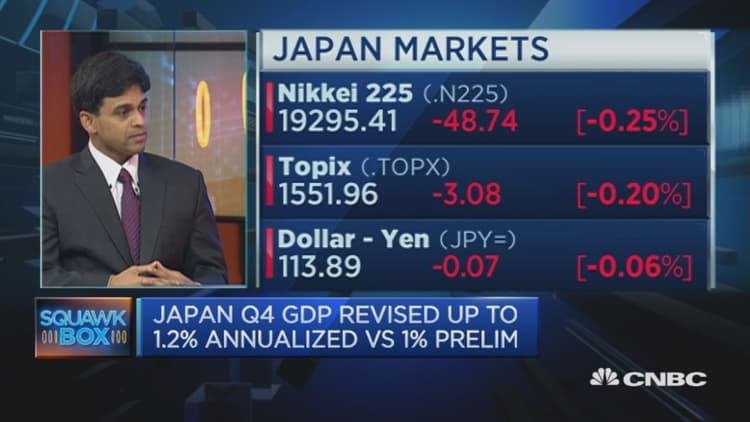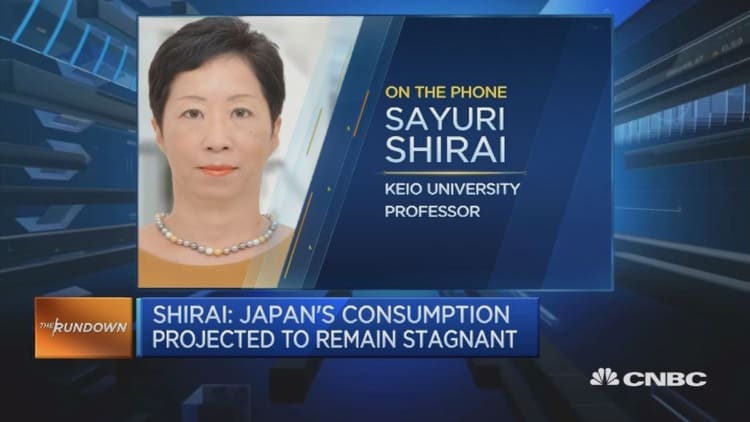
Japan's economy grew faster than initially reported in the final quarter of 2016, with an upward revision in business spending and a jump in investment growth bolstering activity.
Asia's second-largest economy grew at an annualized rate of 1.2 percent in the October-December quarter, revised up from a preliminary reading of 1.0 percent growth, according to new data from the Cabinet Office.
However, the revised figure still undershot market estimates: The median estimate in a Reuters poll of economists had pegged growth at 1.6 percent.
On a quarter-on-quarter basis, gross domestic product (GDP) rose 0.3 percent, versus a preliminary reading of 0.2 percent growth and the median estimate of a 0.4 percent increase.
The latest round of modest data confirms the challenges facing Japanese policymakers, who have been working to support growth and boost inflation after years of economic stagnation.
Japan's economy has grown for four consecutive quarters, a feat not seen in three years, but experts say business investment and private consumption remain soft.
"I think markets were looking for a bit more of a broad based lift," Vishnu Varathan, Senior Economist at Mizuho Bank told Squawk Box.
"Capex exceeded market expectations, while the other components didn't rise to the occasion, so to speak. Household consumption remains weak, and net exports did contribute but it was not stellar."
BOJ Policy Response
As Japan's economy progresses on a slow and gradual recovery trend, former Bank Of Japan (BOJ) board member Sayuri Shirai expects the central bank to remain "constant" at its March 15-16 monetary policy meeting.
"The corporate sector is very cautious of making an investment, mainly because there is a great deal of uncertainty both externally and domestically, because of the declining population. The corporate sector is not very eager to make greater production capacity," she told The Rundown on CNBC.

Professor Shirai was a member of the Policy Board of the Bank of Japan from April 2011 to March 2016. She supported the BOJ's Quantitative and Qualitative Monetary Easing (QQE) program in 2013 and 2014, but voted against the negative interest rate policy in January 2016.
"The important thing is that we see continuous nominal wage growth, together with higher expectations on wage growth. Corporate sector profits are very high historically, but the impact on wages is still limited," she said.
The capital expenditure component of GDP rose 2.0 percent from the previous quarter, which was more than the forecast for 1.7 percent growth, and faster than the preliminary 0.9 percent. Despite the optimism, private consumption registered no growth in October-December and sluggish household spending remains a key challenge.
Professor Shirai said the government needs to work further to raise wages to drive sustainable consumption growth.
Fed Impact
The US Federal Reserve is also set to meet this month, and any increase in policy rates will have a significant impact on Japan, experts say.
"If we see the hike in interest rates in the United States, as a result of higher economic growth and inflation, that might lead to a further depreciation of the yen, which would help profits in the manufacturing sector in Japan," Shirai said.
"I always emphasize at the same time that a greater depreciation of the Yen might not help Japanese consumers and consumption, because wages do not catch up with inflation. We have to balance out between the impact on manufacturing profits and consumption in Japan."
There is an 84.1 percent chance of a hike in U.S interest rates when the Federal Reserve begins its two day policy meeting on March 15, according to the closely watched CME FedWatch Tool.
Risks Ahead
A stronger pace of growth will be a boon to the government as policymakers have been counting on an increase in business investment to drive future expansion and increase low productivity, but risks to the outlook remain.
Growth is not robust enough to generate sustained inflation that the BOJ wants, and the risk of rising protectionism could discourage Japanese exporters from raising wages, seen as key to boosting consumption and economic activity at home.
"The manufacturing sector is very worried about the development of U.S. economic policy," Shirai said.
"I think that is one of the reasons why they are very cautious about making greater business investments. This is the one area where we have a great deal of uncertainty in Japan."
The structural conundrum
Given some of the challenges confronting Japan, there were limits to how much economic vim could be provided by monetary policy alone, Shirai said.
"Interest rates are so low, so interest rates are not the issue any longer when it comes to increasing aggregate demand," Shirai added.
"The issue is more structural. People are very worried about their social security systems and the sustainability of their pension systems, and if you ask young people, they like to save because they're worried about the future."
"The government really has to tackle making the pension system more sustainable. Everybody is worried about their retirement, and this is the most important area that the government has to deal with."

